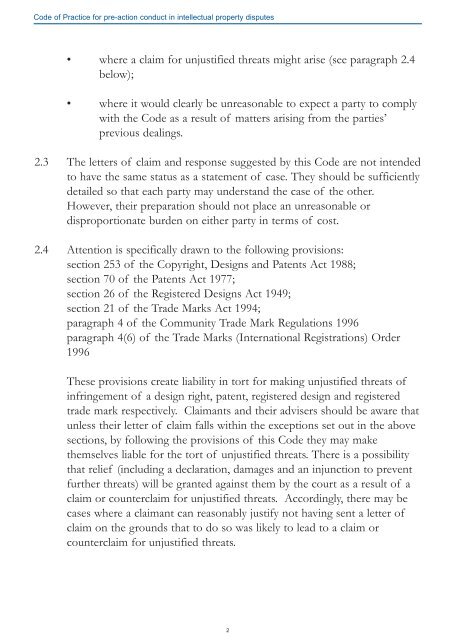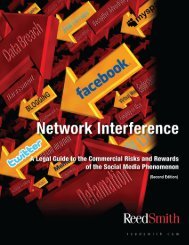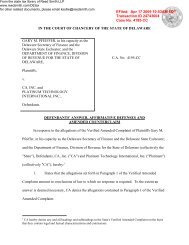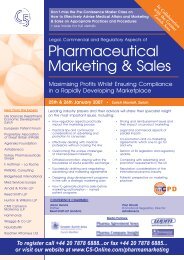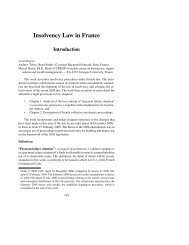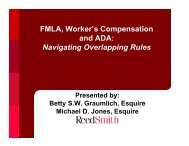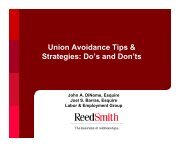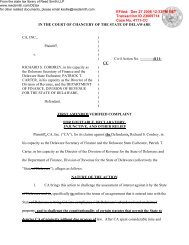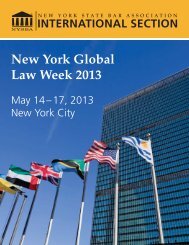Code of Practice for pre-action conduct in intellectual ... - Reed Smith
Code of Practice for pre-action conduct in intellectual ... - Reed Smith
Code of Practice for pre-action conduct in intellectual ... - Reed Smith
You also want an ePaper? Increase the reach of your titles
YUMPU automatically turns print PDFs into web optimized ePapers that Google loves.
<strong>Code</strong> <strong>of</strong> <strong>Practice</strong> <strong>for</strong> <strong>pre</strong>-<strong>action</strong> <strong>conduct</strong> <strong>in</strong> <strong>in</strong>tellectual property disputes<br />
• where a claim <strong>for</strong> unjustified threats might arise (see paragraph 2.4<br />
below);<br />
• where it would clearly be unreasonable to expect a party to comply<br />
with the <strong>Code</strong> as a result <strong>of</strong> matters aris<strong>in</strong>g from the parties’<br />
<strong>pre</strong>vious deal<strong>in</strong>gs.<br />
2.3 The letters <strong>of</strong> claim and response suggested by this <strong>Code</strong> are not <strong>in</strong>tended<br />
to have the same status as a statement <strong>of</strong> case. They should be sufficiently<br />
detailed so that each party may understand the case <strong>of</strong> the other.<br />
However, their <strong>pre</strong>paration should not place an unreasonable or<br />
disproportionate burden on either party <strong>in</strong> terms <strong>of</strong> cost.<br />
2.4 Attention is specifically drawn to the follow<strong>in</strong>g provisions:<br />
section 253 <strong>of</strong> the Copyright, Designs and Patents Act 1988;<br />
section 70 <strong>of</strong> the Patents Act 1977;<br />
section 26 <strong>of</strong> the Registered Designs Act 1949;<br />
section 21 <strong>of</strong> the Trade Marks Act 1994;<br />
paragraph 4 <strong>of</strong> the Community Trade Mark Regulations 1996<br />
paragraph 4(6) <strong>of</strong> the Trade Marks (International Registrations) Order<br />
1996<br />
These provisions create liability <strong>in</strong> tort <strong>for</strong> mak<strong>in</strong>g unjustified threats <strong>of</strong><br />
<strong>in</strong>fr<strong>in</strong>gement <strong>of</strong> a design right, patent, registered design and registered<br />
trade mark respectively. Claimants and their advisers should be aware that<br />
unless their letter <strong>of</strong> claim falls with<strong>in</strong> the exceptions set out <strong>in</strong> the above<br />
sections, by follow<strong>in</strong>g the provisions <strong>of</strong> this <strong>Code</strong> they may make<br />
themselves liable <strong>for</strong> the tort <strong>of</strong> unjustified threats. There is a possibility<br />
that relief (<strong>in</strong>clud<strong>in</strong>g a declaration, damages and an <strong>in</strong>junction to <strong>pre</strong>vent<br />
further threats) will be granted aga<strong>in</strong>st them by the court as a result <strong>of</strong> a<br />
claim or counterclaim <strong>for</strong> unjustified threats. Accord<strong>in</strong>gly, there may be<br />
cases where a claimant can reasonably justify not hav<strong>in</strong>g sent a letter <strong>of</strong><br />
claim on the grounds that to do so was likely to lead to a claim or<br />
counterclaim <strong>for</strong> unjustified threats.<br />
2


